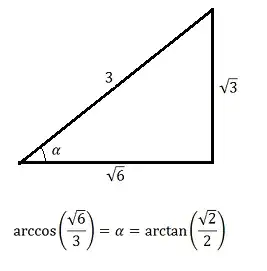I get the following results after solving the equation $\sqrt[4]{1 - \frac{4}{3}\cos(2x) - \sin^4(x)} = -\,\cos(x)$, : $$ x_{1} = \pi - \arccos(\frac{\sqrt{6}}{3}) + 2\pi n: n \in \mathbb{Z}\\ x_{2} = \pi + \arccos(\frac{\sqrt{6}}{3}) + 2\pi n: n \in \mathbb{Z} $$
Wolfram Alpha, here the link, instead, gives the following results:
$ x_{1} = 2\pi n - 2\arctan(\sqrt{5 + 2\sqrt{6}}) : n \in \mathbb{Z}\\ x_{2} = 2\pi n + 2\arctan(\sqrt{5 + 2\sqrt{6}}) : n \in \mathbb{Z} $
Now, supposing that my solutions are correct, this means that there must be a relation between:
$\pi - \arccos(\frac{\sqrt{6}}{3})$ and $- 2\arctan(\sqrt{5 + 2\sqrt{6}})$
or between:
$\pi + \arccos(\frac{\sqrt{6}}{3})$ and $+ 2\arctan(\sqrt{5 + 2\sqrt{6}})$
or viceversa. But, given the solutions I have found, how can I prove that they are effectively the same as the solutions Wolfram found? Mathematically?
P.S.: I have found out, by looking at the graphs of $y_{1} = \pi - \arccos(\frac{\sqrt{6}}{3})$ and $y_{2} = 2\arctan(\sqrt{5 + 2\sqrt{6}})$ e.g., that:
$\pi - \arccos(\frac{\sqrt{6}}{3}) = 2\arctan(\sqrt{5 + 2\sqrt{6}})$
Then, of course: $\pi - \arccos(\frac{\sqrt{6}}{3}) + 2\pi = 2\arctan(\sqrt{5 + 2\sqrt{6}})+ 2\pi \\ \pi - \arccos(\frac{\sqrt{6}}{3}) + 4\pi = 2\arctan(\sqrt{5 + 2\sqrt{6}})+ 4\pi \\ ... every\,\,360°n, n \in \mathbb{Z}$
And that:
$\pi + \arccos(\frac{\sqrt{6}}{3}) = -2\arctan(\sqrt{5 + 2\sqrt{6}})+ 2\pi\\ \pi + \arccos(\frac{\sqrt{6}}{3}) + 2\pi = -2\arctan(\sqrt{5 + 2\sqrt{6}})+ 4\pi\\ \pi + \arccos(\frac{\sqrt{6}}{3}) + 4\pi = -2\arctan(\sqrt{5 + 2\sqrt{6}})+ 6\pi\\ ... \pi + \arccos(\frac{\sqrt{6}}{3}) + (n - 2)\pi = -2\arctan(\sqrt{5 + 2\sqrt{6}})+ n\pi\\ $
So we can say that $\pi + \arccos(\frac{\sqrt{6}}{3}) + (n - 2)\pi$ differs from $-2\arctan(\sqrt{5 + 2\sqrt{6}}) + n\pi$ by just one lap ($2\pi$), otherwise they can be safely considered the same (for all integers).
So how to rewrite $\arccos$ in terms of $\arctan$?
Thanks for the attention!
